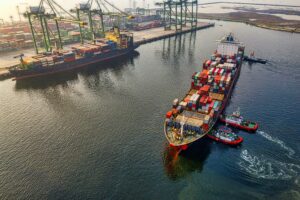Decoding Maritime Emissions: Insights from Q2 2025 by VesselBot

Global shipping continues to be the backbone of world trade, carrying around 90% of all goods. Yet, as trade routes shift under the pressure of geopolitical events, economic policies, and environmental regulation, the industry faces increasing scrutiny over its carbon footprint. VesselBot’s latest report, Decoding Maritime Emissions, Q2 2025, provides a comprehensive, data-driven look at how the sector is evolving.
Key Industry Dynamics
In the second quarter of 2025, 72,516 voyages were carried out by 4,865 containerships. While the number of voyages was slightly lower than the same period last year (down 0.3%), the fleet itself grew by 8%, reflecting the large number of new vessel deliveries entering the market.
Trade disruptions continued to shape shipping patterns. Security risks in the Red Sea and Suez Canal rerouted many vessels around the Cape of Good Hope, increasing voyage distances and fueling port congestion. Meanwhile, U.S. tariff policies drove fluctuations in transpacific trade volumes, with a strong start to the year giving way to slower activity in the spring.
Emissions and Efficiency
The industry recorded 46.8 million tons of CO₂ emissions in Q2, a 4.5% decrease year-on-year. Average well-to-wake (WTW) cargo emissions intensity fell by 1.5% to 196.6 g CO₂e per TEU-km, signaling incremental progress in efficiency.
However, the broader picture is mixed. While Q2 showed improvements, emissions for the first half of 2025 actually rose by nearly 1% compared to the same period in 2024, largely due to higher activity and rerouting in Q1.
Vessel Size and Age Matter
The report highlights the clear relationship between vessel size and emissions intensity:
-
Feeder ships (up to 2,999 TEU) made up nearly half of all voyages and accounted for 26.7% of total emissions, with the highest intensity levels.
-
Very Large Container Ships (VLCS), carrying more than 17,000 TEU, were the most efficient, producing an average WTW intensity of just 60.3 g CO₂e per TEU-km.
Newer ships also outperformed older ones. Vessels under 5 years old averaged 183 g CO₂e per TEU-km, while those over 20 years old posted intensities of 234 g, despite operating at slower speeds.
Routes and Regional Trends
Major fronthaul routes tell a nuanced story.
-
The Asia–Northern Europe trade recorded the highest total emissions per voyage (13,185 tons), but the lowest intensity (57.3 g) thanks to very high utilization and the deployment of VLCS.
-
The North Europe–North America East Coast trade was the least efficient, with an intensity of 110 g, despite its shorter distances.
-
Voyages within Asia and regional trades often showed the highest intensity, due to smaller vessels, lower utilization, and shorter travel distances.
Shipbuilding Shifts
China has emerged as the dominant shipbuilding hub, accounting for more than one-third of the global fleet and over half of all vessels under five years old. South Korea, meanwhile, specializes in building larger ships, which explains why voyages by Korean-built vessels reported the lowest emissions intensity.
Why This Matters
The findings reinforce the importance of data-driven monitoring in helping carriers, shippers, and regulators understand where emissions reductions can be achieved. Larger, newer, and more efficient vessels clearly play a role, but operational strategies—such as optimizing speed, routing, and utilization—remain just as critical.
With mounting regulatory pressure, including California’s strict new climate disclosure laws and evolving EU policies, companies will need accurate, real-time insights to navigate compliance and meet sustainability goals.
Looking Ahead
VesselBot’s analysis shows that shipping is making gradual progress in efficiency, but absolute emissions remain stubbornly high due to the sheer scale of global trade. The industry’s path forward will rely on scaling up alternative fuels, accelerating fleet modernization, and leveraging advanced data tools to make smarter operational choices.
As VesselBot notes, only with real-time emissions intelligence can companies balance trade efficiency with sustainability in an increasingly complex maritime landscape.
The post Decoding Maritime Emissions: Insights from Q2 2025 by VesselBot appeared first on Container News.
Content Original Link:
" target="_blank">

































































